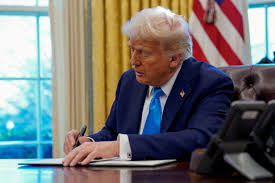With July 9 tariff deadline approaching, what to know about Trump administration’s trade deals

As the July 9 deadline for reinstating reciprocal tariffs draws closer, trade officials around the world are scrambling to secure last-minute agreements with the United States. The pause on tariffs, announced by former President Donald Trump in April, was meant to give negotiating partners a 90-day window to finalize new trade arrangements. But with just days to go, only a few deals have been completed — and uncertainty looms over what could come next.
This article explains what the July 9 deadline means, which countries are affected, and what the broader implications are for global trade and the U.S. economy.
Understanding the July 9 Deadline
In a bold move during his second term, Trump introduced a “reciprocal tariff” framework, under which countries that impose high duties on American goods would face similar tariffs in return. This marked a return to his earlier “America First” trade philosophy, emphasizing fairness and bilateral accountability.
In April 2025, Trump temporarily suspended many of these tariffs to allow for a 90-day negotiation period. The deadline for that suspension ends on July 9, 2025. If no deal is reached with a specific country, the U.S. will reimpose a base tariff of 10%, with the possibility of raising it even higher — in some cases up to 50% — depending on the perceived trade imbalance.
Which Countries Have Secured Deals?
So far, only two major trading partners — the United Kingdom and China — have reached agreements with the Trump administration. The U.K. deal includes agricultural and tech trade provisions, while the China deal reportedly focuses on intellectual property protections and reduced subsidies for state-owned enterprises.
Negotiations with other key economies, however, remain unresolved. These include:
- European Union: The EU is deeply divided internally over how to respond. France and Germany favor striking a deal, while countries like Italy and Spain are reluctant to concede on agriculture and digital services.
- India: Talks have stumbled on issues such as auto tariffs, steel exports, and import duties on liquor. Indian negotiators have pushed back against U.S. demands, citing domestic economic concerns.
- Canada: The situation with Canada is especially tense. Ottawa’s recent enactment of a digital services tax drew sharp criticism from the Trump administration, which responded by halting progress on a bilateral deal.
- Japan and South Korea: Both nations are considered close to an agreement, but key issues remain around industrial subsidies and automobile quotas.
Why Is This Deadline Important?
For the global economy, July 9 could be a turning point. If reciprocal tariffs are reinstated broadly, it could trigger a chain reaction of retaliatory measures from other countries. Businesses that rely on imported parts or export U.S.-made goods to foreign markets are especially vulnerable.
Industries such as:
- Automotive manufacturing
- Consumer electronics
- Agricultural exports
- Steel and aluminum
…are closely monitoring developments, as even a 10% tariff can significantly alter pricing and supply chain decisions.
Is the Deadline Flexible?
Technically, yes — but the political tone says otherwise.
While White House Press Secretary Karoline Leavitt stated that the deadline is “not set in stone,” former President Trump recently told Fox News that he has “no plans to extend” the tariff pause. That said, he did leave a small window open for “special cases,” suggesting that extensions could be granted to nations showing good-faith progress.
This ambiguity adds to the market’s uncertainty. Investors dislike unpredictability, and several stock analysts have noted that July could be a volatile month for trade-sensitive sectors.
Economic Implications
The return of widespread tariffs may offer short-term political gains — particularly with Trump’s base of industrial workers and domestic manufacturers. But economists are divided on the long-term impact.
Some argue that tariffs could increase federal revenue and force foreign governments to lower their own trade barriers. Others caution that higher import prices could:
- Fuel inflation
- Disrupt supply chains
- Invite retaliatory tariffs on U.S. exports
- Prompt legal challenges under the World Trade Organization
The Federal Reserve is also watching closely. If tariffs reignite inflation, it could delay planned interest rate cuts, affecting everything from mortgage rates to credit card APRs.
Legal and Strategic Hurdles
Adding to the complexity is a recent ruling by a U.S. trade court that found parts of Trump’s tariff policy illegal under the International Emergency Economic Powers Act (IEEPA). The decision hasn’t been enforced due to an ongoing appeal, but it casts a legal shadow over the broader strategy.
Meanwhile, countries like Mexico, Brazil, and Vietnam are adopting a wait-and-see approach, choosing not to engage in full negotiations until they have clarity on the U.S. stance post-July 9.
What Happens If Deals Aren’t Reached?
If no significant progress is made by July 9, the U.S. will begin automatically applying baseline tariffs to non-exempt nations. This could:
- Spark new trade disputes
- Create tension within multilateral alliances (e.g., NATO, ASEAN)
- Push some countries toward alternative trade partners, like China or the EU
The ripple effects could also extend to emerging markets, many of which depend on stable U.S. trade access for growth.
Conclusion
With just days remaining until the July 9 deadline, the Trump administration is under pressure to convert negotiations into tangible deals. While some countries are close to finalizing agreements, many others remain far from consensus. The next week will be crucial not only for trade but also for global economic stability.
Whether Trump chooses to enforce, delay, or selectively apply the tariffs will shape the direction of U.S. foreign trade policy for the rest of 2025 — and potentially well into the next decade.






